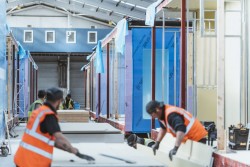Traditional construction methods continue to drive the industry's significant carbon footprint. David Harris, CEO, Premier Modular, explores how modular construction is the solution to decreasing carbon emissions associated with building.
According to the UN's Global Status Report for Buildings and Construction, 10 billion tonnes of carbon dioxide emissions were produced globally through the operation, maintenance and management of buildings in 2022. With the effects of the climate crisis intensifying year on year, the need for modern methods of construction that reduce embodied and operational carbon is growing. Modular construction is one such example, a form of offsite building that research has shown produces up to 45 per cent less emissions than traditional methods.
From design to installation, modular construction can help organisations improve their footprint and relieve pressures to meet sustainability targets.
Incorporating low carbon into design
By adopting a fabric-first approach, organisations reduce the carbon emissions produced through heating, cooling and other operations, because they make energy efficiency a priority at the design stage.
From the outset, consideration should be given to a building's massing and orientation, as these will directly impact how much energy is used to maintain and use the facility. For instance, a south-facing building that's exposed to more sunlight, could be made energy-efficient, more easily, by incorporating a greater number of windows to limit the use of electric lighting. It is difficult to retrofit these decisions after the design stage.
Modular construction takes into account the massing and orientation considerations of a specific site, so that modules are configured appropriately.
When designing a building to reduce carbon, small changes in the design and manufacturing processes can make a big difference to the operational carbon a building will use in its lifetime. The precision manufacturing involved in modular construction can support whatever energy efficient design is required – ie limiting heat loss caused by thermal bridging, along with far greater accuracy of construction. This allows for maximising the efficiency of the building envelope, reducing air permeability and minimising the amount of energy required to replace lost heat.
Incorporating systems – such as mechanical ventilation with heat recovery (MVHR) to circulate fresh, warm air throughout the building – can improve the energy efficiency of a building even further. MVHR can be combined with other carbon-reducing design features – such as rainwater harvesting systems and photovoltaic panels – all of which are easily integrated into modular solutions.
Reducing embodied carbon with modular solutions
When designing and developing your building, choosing less carbon-intensive materials is a key factor in reducing its carbon footprint.
Materials often used in traditional construction, such as reinforced concrete and clay brick, have a lot of embodied carbon. Reinforced concrete has an average of 635kg of embodied carbon per m3. This means traditional building materials require a lot of energy to produce and transport to site, increasing a building's embodied carbon as a result.
Modular construction resolves this by building offsite which cuts down transport emissions. The use of lighter weight products helps to reduce emissions further because the use of carbon-intensive building materials is minimised.
This is reinforced by the minimal waste produced from the precision manufacturing involved in modular construction which in turn limits the amount of energy needed to cut materials into the right size or shape. At Premier Modular, we're taking this one step further, with zero waste to landfill from our factories.
Unlike other buildings, modular buildings can also be recycled, decreasing the embodied carbon in the UK's building landscape. Without the creation of a new building, the energy required to construct it is not needed. Modular buildings can therefore be tailored to meet the needs of new owners, extending their lifecycle and enabling organisations to limit their carbon footprints.
Looking forward to reducing carbon…
To achieve net zero carbon status, a building must have no operational or embodied emissions associated with its construction, use or maintenance. When evaluating ways to reduce carbon linked with buildings, organisations should aim to choose suppliers who consider green technology at every stage of a building's lifecycle.
The design for manufacturing and assembly (DFMA) technology used in modular construction is helping organisations reduce their carbon emissions by optimising the materials used and limiting the amount of energy spent on modifications. Such efficiency is what makes modular construction the viable solution to make real in-roads into the industry's enormous carbon footprint.
For further information about modular solutions improving sustainability in construction, visit: https://www.premiermodular.co.uk/how-can-modular-solutions-improve-sustainability-in-construction/
Original source: Decarbonising construction: why modular buildings are improving the industry's footprint - Industry News (premierconstructionnews.com)









